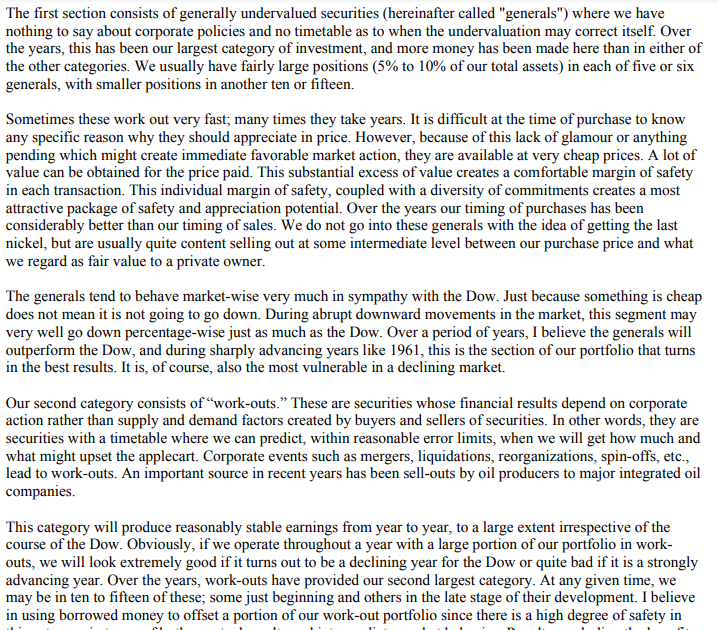Warren Buffett started his investment career in the 1950s by focusing on traditional value investing strategies, as practiced by Ben Graham
You can rea about the three categories of investments he made here: (Source: Buffett Partnership Letters)
These were plentiful up until the late 1950s and the early 1960s.
It allowed him to compound at high rate of return.
Unfortunately, these started drying up, as the stock market was in the midst of exuberance and stocks were bid up.
In addition, his assets under management were growing and reaching a big enough size, where he needed larger investments to move the needle. Traditional value investing strategies had a maximum carrying capacity that he had outgrown.
So Buffett had to adapt to his environment.
He still focused on buying value, but had to redefine how value is defined.
“Far better to buy good company at a decent price than bad one at a steal price”
He started understanding the value of franchises.
He did two particular investments at the time.
One was buying Disney (DIS).
Another was buying American Express (AXP).
He sold Disney for a quick 50% gain.
He held on to AXP and sold for a triple.
He then wound up his partnership in 1969, citing unfavorable and frothy market conditions and started focusing on building out Berkshire Hathaway as his second retirement project. In his words, he had retired at 25 actually.
Yet, while he never really mentions it, he probably saw Disney and AXP delivered amazing returns through 1972. Those companies kept growing and delivering to shareholders. Everyone was enthusiastic about their prospects during the Nifty-Fifty boom.
Check out the page for Disney from the 1980 Moody’s Manual of Stocks
Even after it went bust in 1973- 1974 bear market, these stocks were still selling much above the levels at which Buffett sold them. They then managed to deliver amazing returns too.
However, they were selling at inflated valuations in 1971 – 1972, which were unsustainable. They had in fact pulled forward returns to the present and investors were paying dearly for the growth of the next decade. With a high degree of certainty and lack of any meaningful margin of safety.
Disney sold at 50 – 60 times earnings between 1971 and 1973. That was a time to clearly take advantage of the irrational exuberance and sell. Even in 1970, the stock was selling at a P/E of 30, which was high. By 1980, Disney stock was selling at close to the levels it did close to a decade earlier, and generating no real returns to anyone that bought the stock at those high valuations. That’s despite the fact that the company managed to grow earnings per share pretty well. This was a result of the valuation multiple shrinking to a P/E of 11 by 1980.
American Express did sell at a high valuation in 1971- 1973 of roughly 25 – 30 times earnings. It was not as high as that of Disney, but still elevated. Forward returns were also pulled forward in this case as well. By 1980 however, the stock sold at the same levels as those from a decade earlier. That’s despite the fact that earnings oer share grew. This lack of returns was mostly as a result of the shrinking in the valuation to a P/E of 7.
I am sure that this experience reinforced the idea for Buffett to buy quality companies and hold them. If you buy a good business, the right time to sell is never.
This example probably sat on the back of his mind, as Buffett does like to revisit his old investments. That’s how he has come up with the sins of omission and sins of commission.
In hindsight, selling those great businesses when they became too overvalued in 1971- 1972 would have likely been a smart move. But timing is always tricky, and there are also costs associated with selling. You have taxes and opportunity cost – aka the cost you may have sold too early, and that you are wrong on the company you sell. After all, valuation is part art, and part science. A stock may look expensive at 30 – 40 times earnings but only optically. If that company managed to deliver EPS growth that is dependable and long lasting, it may turn out to be a steal in hindsight. On the other hand, a stock selling at a P/E of 10 may turn out to be expensive, if it ends up stagnating EPS or even seeing them decline and turns out to be a melting ice cube.
That being said, at some astronomical price, it may not make sense to hold on to a security, because forward returns may be terrible. Think Nikkei 225 selling at 100 times earnings in 1989 or dot-com companies selling at 100+ times earnings in 1999.
Next, Buffett was able to acquire See’s Candies in 1972 at a very good price and saw it grow earnings at a steady and consistent clip, while also showering him with billions of dollars in dividends to allocate elsewhere.
He then went ahead and bought Coca-Cola in 1988 – 1994. This consumer company kept growing, and investors bid up the stock. It went from 15 times earnings in the late 1980s to close to 30 times earnings in the early 1990s. The stock sold above 40 times forward earnings in 1997 – 1998, which incidentally was also around the time that EPS hit a high point that it didn’t exceed for several years.
A high multiple at the start, coupled with stagnating EPS is a recipe for disaster for investors in a high-flying growth stock. Speculators run for the exits, negative news articles circle around, and the valuation multiple shrinks, leading to poor total returns. Only a consistent and growing dividend could have kept investors sane and holding.
That being said, Buffett seems to have felt that Coca-Cola is indeed overvalued in 1997 – 1998. He has expressed regrets for not selling it at a high valuation. In hindsight, he could have done well as the stock didn’t have great returns really for a long time as valuation was shrinking.
In a way he did reduce portfolio exposure to Coca-Cola in 1998, since he acquired General RE, which had a substantial fixed income portfolio. This in effect diluted Coca-Cola impact on Berkshire Hathaway overall portfolio. But he would have likely still done better selling it. I know, hindsight is 50/50. But from a forward returns perspective, it would have made sense to allocate the funds elsewhere. But only because the valuation was egregiously high.
Buffett doesn’t really time the markets. But he does seem to be very picky about buying good companies at a good valuation. A lower valuation provides higher expected returns.
He does seem to be learning from his lessons, as he has also worked to try and reduce position sizes if valuation is too high.
For example, he recently reduced his exposure to Apple. It makes sense that he is doing this, as Apple has not really grown the business by much, yet sells at a P/E of 32+. The company is great, but overvalued.
The situation today valuation wise is much different than the situation in 2016/2017 when Buffett was buying it at a P/E of 10.
Future returns were pulled forward through that multiple re-rating.
Perhaps Buffett is learning from all his experience after all (of course he is).
That being said, that doesn’t mean Apple will crumble and fall to zero. It could still deliver very good results and surprise everyone. But from today’s information that we have, the most likely scenario is that forward expected returns are not so hot. Which means that there may be other opportunities that could deliver high expected returns, even after accounting for taxes on sales.
It may not always turn out to be correct. For example, he sold Costco around the $300’s, which was a high P/E. Yet, the stock is now almost a triple from there and still has a high P/E. But those are more of an exception than the rule.
For example, selling at a high valuation may work some times. But others, it may not. In the case of Costco, selling at high P/E in 2017 – 2023 seems to have been a mistake. But selling in 1999 – 2000 would have been a smart choice.
In the case of Coca-Cola, the stock sold at a high P/E as early as 1992. But selling then would have been a mistake as you would have missed on four fold increase in stock prices. But selling at a high P/E of 1997/1998 would have been smart. Again, hindsight is always 20/20.
While the experience of ignoring high P/E ratios in early 1990s paid off, they were actually costly to ignore in the late 1990s. Some lessons learned during one market environment may turn out to be wrong in another. Some experience is valuable during some times, but detrimental during others.
Perhaps Buffett is selling Apple today because it is overvalued, and earnings per share growth is not really very strong. Any share buybacks to prop earnings growth would not have the same effect at a P/E of 30 that they may have had at a P/E of 10. He’s learned that selling may be a good idea overall, despite the opportunity costs involved. That’s because forward return projections do not look very exciting for Apple investors from here.
That being said, Apple has been written off as an “expensive has been” for a long time. Even when the P/E ratio was low about 8 years ago, some folks were arguing that the P/E is high assuming earnings per share collapse as “the company is no longer innovating” amid fears that Apple’s products would suffer the fate of other once hot technology companies that went into oblivion (Blackberry anyone?).
So it is possible that Buffett’s sale is a mistake. But for his opportunity set, probably not as high probability wise. Of course, the game of investing is about probabilities, and things are not certain until after the fact (which is when you can tally who won and who lost).
The game of investing is fascinating, because there are no hard and fast rules. The same type of logic and reasoning could work very well under one set of conditions, and fail miserably under another. The investor can only hope that consistent application of sound principles could average out to an overall record of profits.
You need to keep learning, but also beware that you may end up being fooled by randomness as well.
However, to stand a chance in this game of investing, you need to try an improve the odds of survival, before improving your odds of succeeding.
Those include buying quality businesses with strong moats at attractive valuations, and then holding them for as long as it makes sense. While this goes contrary to what Buffett does, us mere mortals should diversify and avoid leverage in order to increase our staying power in a position. Last but not least, keeping costs low matters a lot, as well as making sure we have the proper behavioral mindset that would allow us to avoid being scared from stock market fluctuations. However, we do need an exit plan when we buy a stock, and follow it religiously.



.jpg)




